Blue Exciplexes in Organic Light-Emitting Diodes: Opportunities and Challenges
Abstract
1. Introduction
2. Photophysical Mechanisms of Blue Exciplexes
3. Blue Exciplex as the Emitter in OLEDs
3.1. Exciplex as an Emitter in Blue OLEDs
3.2. Exciplex as an Emitter in WOLEDs
4. Blue Exciplexes as Hosts and Cohosts in OLEDs
4.1. Blue Exciplexes as Host in OLEDs
4.2. WOLEDs Based on Blue Exciplexes as Hosts
5. Conclusions
Author Contributions
Funding
Institutional Review Board Statement
Informed Consent Statement
Data Availability Statement
Conflicts of Interest
Abbreviations
| CE | Current efficiency |
| CIE | Commission Internationale de l’Éclairage |
| CT | Charge transfer |
| ΔEST | Singlet-triplet energy gap |
| EQE | External quantum efficiency |
| FMO | Frontier Molecular Orbital |
| HOMO | Highest Occupied Molecular Orbital |
| IQE | Internal quantum efficiency |
| LUMO | Lowest Unoccupied Molecular Orbital |
| MDPI | Multidisciplinary Digital Publishing Institute |
| MR-TADF | Multi-resonance thermally activated delayed fluorescence |
| NTSC | National Television System Committee |
| OLED | Organic light-emitting diode |
| PE | Power efficiency |
| PhOLED | Phosphorescent organic light-emitting diode |
| PLQY | Photoluminescence quantum yield |
| RISC | Reverse intersystem crossing |
| TADF | Thermally activated delayed fluorescence |
| TRPL | Time-Resolved Photoluminescence |
| TTET | Triplet-triplet energy transfer |
| TTF | Triplet-triplet fusion |
| WOLED | White organic light-emitting diode |
| −ΔGcs | Driving force |
| TSF | TADF-sensitized fluorescence |
| FWHM | Full width at half maximum |
References
- Kido, J.; Shionoya, H.; Nagai, K. Single-Layer White Light-Emitting Organic Electroluminescent Devices Based on Dye-Dispersed Poly(N-Vinylcarbazole). Appl. Phys. Lett. 1995, 67, 2281–2283. [Google Scholar] [CrossRef]
- Hu, B.; Yang, Z.; Karasz, F.E. Electroluminescence of Pure Poly(N-Vinylcarbazole) and Its Blends with a Multiblock Copolymer. J. Appl. Phys. 1994, 76, 2419–2422. [Google Scholar] [CrossRef]
- Tang, C.W.; VanSlyke, S.A. Organic Electroluminescent Diodes. Appl. Phys. Lett. 1987, 51, 913–915. [Google Scholar] [CrossRef]
- Baldo, M.A.; O’Brien, D.F.; Thompson, M.E.; Forrest, S.R. Excitonic Singlet-Triplet Ratio in a Semiconducting Organic Thin Film. Phys. Rev. B 1999, 60, 14422. [Google Scholar] [CrossRef]
- Zhao, B.; Zhang, H.; Miao, Y.; Wang, Z.; Gao, L.; Wang, H.; Hao, Y.; Li, W. High Color Stability and CRI (>80) Fluorescent White Organic Light-Emitting Diodes Based Pure Emission of Exciplex by Employing Merely Complementary Colors. J. Mater. Chem. C 2017, 6, 304–311. [Google Scholar] [CrossRef]
- Luo, D.; Li, X.-L.; Zhao, Y.; Gao, Y.; Liu, B. High-Performance Blue Molecular Emitter-Free and Doping-Free Hybrid White Organic Light-Emitting Diodes: An Alternative Concept to Manipulate Charges and Excitons Based on Exciplex and Electroplex Emission. ACS Photonics 2017, 4, 1566–1575. [Google Scholar] [CrossRef]
- Pope, M.; Swenberg, C.E. Electronic Processes in Organic Crystals and Polymers; Oxford University Press: New York, NY, USA, 1999. [Google Scholar]
- Adachi, C.; Baldo, M.A.; Thompson, M.E.; Forrest, S.R. Nearly 100% Internal Phosphorescence Efficiency in an Organic Light-Emitting Device. J. Appl. Phys. 2001, 90, 5048–5051. [Google Scholar] [CrossRef]
- Baldo, M.A.; O’Brien, D.F.; You, Y.; Shoustikov, A.; Sibley, S.; Thompson, M.E.; Forrest, S.R. Highly Effcient Phosphorescent Emission from Organic Electroluminescent Devices. Nature 1998, 395, 151–154. [Google Scholar] [CrossRef]
- Wang, Q.; Tian, Q.-S.; Zhang, Y.-L.; Tang, X.; Liao, L.-S. High-Efficiency Organic Light-Emitting Diodes with Exciplex Hosts. J. Mater. Chem. C 2019, 7, 11329–11360. [Google Scholar] [CrossRef]
- Sarma, M.; Chen, L.-M.; Chen, Y.-S.; Wong, K.-T. Exciplexes in OLEDs: Principles and Promises. Mater. Sci. Eng. R Rep. 2022, 150, 100689. [Google Scholar] [CrossRef]
- Goushi, K.; Adachi, C. Delayed Fluorescence by Reverse Intersystem Crossing and Application to Organic Light-Emitting Diodes. In Proceedings of the Conference on Lasers and Electro-Optics 2012, San Jose, CA, USA, 6–11 May 2012; OSA: San Jose, CA, USA, 2012; p. CF1A.1. [Google Scholar]
- Lim, H.; Shin, H.; Kim, K.-H.; Yoo, S.-J.; Huh, J.-S.; Kim, J.-J. An Exciplex Host for Deep-Blue Phosphorescent Organic Light-Emitting Diodes. ACS Appl. Mater. Interfaces 2017, 9, 37883–37887. [Google Scholar] [CrossRef]
- Jiang, J.; Lin, X.; Lei, H.; Li, J.; Kou, Z. The Effect of the Exciplex Heterojunction Interlayer on Efficiency Roll-off in Non-Doped Blue Phosphorescent Organic Light-Emitting Diodes. Opt. Mater. 2020, 99, 109561. [Google Scholar] [CrossRef]
- Zhao, B.; Liu, Z.; Wang, Z.; Zhang, H.; Li, J.; Wang, H.; Xu, B.; Wu, Y.; Li, W. Structural Design for Highly Efficient Pure Fluorescent Warm WOLEDs by Employing TADF Molecule as Blue Emitter and Exciplex Donor. Org. Electron. 2019, 73, 1–6. [Google Scholar] [CrossRef]
- Zhang, Y.; Wang, B.; Yuan, Y.; Hu, Y.; Jiang, Z.; Liao, L. Solution-Processed Thermally Activated Delayed Fluorescence Exciplex Hosts for Highly Efficient Blue Organic Light-Emitting Diodes. Adv. Opt. Mater. 2017, 5, 1700012. [Google Scholar] [CrossRef]
- Park, H.; Maheshwaran, A.; Moon, C.; Lee, H.; Reddy, S.S.; Sree, V.G.; Yoon, J.; Kim, J.W.; Kwon, J.H.; Kim, J.; et al. External Quantum Efficiency Exceeding 24% with CIE y Value of 0.08 Using a Novel Carbene-Based Iridium Complex in Deep-Blue Phosphorescent Organic Light-Emitting Diodes. Adv. Mater. 2020, 32, 2002120. [Google Scholar] [CrossRef]
- Anandan, M.; Kment, S.; Zboril, R.; Kalytchuk, S.; Janusas, G.; Managutti, P.B.; Mohamed, S.; Mazloumihaghghi, R.; Hosseinnezhad, M.; Nunzi, J.M.; et al. High Triplet Hexahydroacridine Derivatives as a Host Prevent Exciton Diffusion to Adjacent Layers in Solution Processed OLEDs. Org. Electron. 2025, 136, 107162. [Google Scholar] [CrossRef]
- Yadav, R.A.K.; Dubey, D.K.; Chen, S.-Z.; Liang, T.-W.; Jou, J.-H. Role of Molecular Orbital Energy Levels in OLED Performance. Sci. Rep. 2020, 10, 9915. [Google Scholar] [CrossRef]
- Li, J.; Li, Z.; Liu, H.; Gong, H.; Zhang, J.; Guo, Q. Advances in Blue Exciplex–Based Organic Light-Emitting Materials and Devices. Front. Chem. 2022, 10, 952116. [Google Scholar] [CrossRef]
- Hippola, C.; Danilovic, D.; Bhattacharjee, U.; Perez-Bolivar, C.; Sachinthani, K.A.N.; Nelson, T.L.; Anzenbacher, P.; Petrich, J.W.; Shinar, R.; Shinar, J. Bright Deep Blue TADF OLEDs: The Role of Triphenylphosphine Oxide in NPB/TPBi:PPh3 O Exciplex Emission. Adv. Opt. Mater. 2020, 8, 0191282. [Google Scholar] [CrossRef]
- Xia, Q.; Xiang, Y.; Gong, Y.; Li, S.; Wu, Y.; Wang, Z.; Fu, H. Development of a Deep-Blue Exciplex as an Emitter and a Host for Highly Efficient and Wide-Color OLEDs. J. Mater. Chem. C 2023, 11, 6354–6359. [Google Scholar] [CrossRef]
- Zhang, Z.; Dou, D.; Xia, R.; Wu, P.; Spuling, E.; Wang, K.; Cao, J.; Wei, B.; Li, X.; Zhang, J.; et al. Efficient Deep-Blue Luminescence Based on Dual-Channel Intra/Intermolecular Exciplexes. Sci. Adv. 2023, 9, eadf4060. [Google Scholar] [CrossRef]
- Li, J.; Gong, H.; Zhang, J.; Liu, H.; Tao, L.; Wang, Y.; Guo, Q. Efficient Exciplex-Based Deep-Blue Organic Light-Emitting Diodes Employing a Bis(4-Fluorophenyl)Amine-Substituted Heptazine Acceptor. Molecules 2021, 26, 5568. [Google Scholar] [CrossRef]
- Gebler, D.D.; Wang, Y.Z.; Blatchford, J.W.; Jessen, S.W.; Fu, D.-K.; Swager, T.M.; MacDiarmid, A.G.; Epstein, A.J. Exciplex Emission in Bilayer Polymer Light-Emitting Devices. Appl. Phys. Lett. 1997, 70, 1644–1646. [Google Scholar] [CrossRef]
- Goushi, K.; Yoshida, K.; Sato, K.; Adachi, C. Organic Light-Emitting Diodes Employing Efficient Reverse Intersystem Crossing for Triplet-to-Singlet State Conversion. Nat. Photon. 2012, 6, 253–258. [Google Scholar] [CrossRef]
- Itano, K.; Ogawa, H.; Shirota, Y. Exciplex Formation at the Organic Solid-State Interface: Yellow Emission in Organic Light-Emitting Diodes Using Green-Fluorescent Tris(8-Quinolinolato)Aluminum and Hole-Transporting Molecular Materials with Low Ionization Potentials. Appl. Phys. Lett. 1998, 72, 636–638. [Google Scholar] [CrossRef]
- Liu, X.; Chen, Z.; Zheng, C.; Liu, C.; Lee, C.; Li, F.; Ou, X.; Zhang, X. Prediction and Design of Efficient Exciplex Emitters for High-Efficiency, Thermally Activated Delayed-Fluorescence Organic Light-Emitting Diodes. Adv. Mater. 2015, 27, 2378–2383. [Google Scholar] [CrossRef]
- Baek, H.J.; Lee, S.E.; Lee, H.W.; Yun, G.J.; Park, J.; Kim, W.Y.; Kim, Y.K. White Organic Light-Emitting Diodes Using Exciplex Emission with Multiple Emitting Layers. Phys. Status Solidi (A) 2018, 215, 1700530. [Google Scholar] [CrossRef]
- Zhang, T.; Zhao, B.; Chu, B.; Li, W.; Su, Z.; Wang, L.; Wang, J.; Jin, F.; Yan, X.; Gao, Y.; et al. Blue Exciplex Emission and Its Role as a Host of Phosphorescent Emitter. Org. Electron. 2015, 24, 1–6. [Google Scholar] [CrossRef]
- Zhang, M.; Ma, X.-C.; Zhang, H.-Y.; Yang, G.; Lin, H.; Zheng, C.-J.; Du, X.; Tao, S. Utilizing Spiro-Type Backbone Donor to Develop Exciplex Emitter and Highly Efficient Phosphorescent OLEDs With Low Efficiency Roll-Off. IEEE Trans. Electron Devices 2024, 71, 6864–6870. [Google Scholar] [CrossRef]
- Zhao, J.; Yuan, S.; Du, X.; Li, W.; Zheng, C.; Tao, S.; Zhang, X. White OLEDs with an EQE of 21% at 5000 Cd m−2 and Ultra High Color Stability Based on Exciplex Host. Adv. Opt. Mater. 2018, 6, 1800825. [Google Scholar] [CrossRef]
- Cheng, W.-C.; Tsai, M.R.; Chen, S.-A. Creation of Dual Thermally Activated Delayed-Fluorescence Exciplexes in a Bulk Emitting Layer and Its Interface with an Electron Transport Layer for Promoting the Performance of Thermally Activated Delayed-Fluorescence Organic Light-Emitting Diodes Fabricated by a Solution Process. ACS Appl. Mater. Interfaces 2023, 15, 31692–31702. [Google Scholar] [CrossRef]
- Liu, X.; Chen, Z.; Qing, J.; Zhang, W.; Wu, B.; Tam, H.L.; Zhu, F.; Zhang, X.; Lee, C. Remanagement of Singlet and Triplet Excitons in Single-Emissive-Layer Hybrid White Organic Light-Emitting Devices Using Thermally Activated Delayed Fluorescent Blue Exciplex. Adv. Mater. 2015, 27, 7079–7085. [Google Scholar] [CrossRef]
- Jankus, V.; Chiang, C.; Dias, F.; Monkman, A.P. Deep Blue Exciplex Organic Light-Emitting Diodes with Enhanced Efficiency; P-type or E-type Triplet Conversion to Singlet Excitons? Adv. Mater. 2013, 25, 1455–1459. [Google Scholar] [CrossRef]
- Kim, H.-B.; Kim, J.-J. Recent Progress on Exciplex-Emitting OLEDs. J. Inf. Disp. 2019, 20, 105–121. [Google Scholar] [CrossRef]
- Ban, X.; Sun, K.; Sun, Y.; Huang, B.; Jiang, W. Design of High Triplet Energy Electron Transporting Material for Exciplex-Type Host: Efficient Blue and White Phosphorescent OLEDs Based on Solution Processing. Org. Electron. 2016, 33, 9–14. [Google Scholar] [CrossRef]
- Lee, J.; Cheng, S.; Yoo, S.; Shin, H.; Chang, J.; Wu, C.; Wong, K.; Kim, J. An Exciplex Forming Host for Highly Efficient Blue Organic Light Emitting Diodes with Low Driving Voltage. Adv. Funct. Mater. 2015, 25, 361–366. [Google Scholar] [CrossRef]
- Park, Y.-S.; Kim, K.-H.; Kim, J.-J. Efficient Triplet Harvesting by Fluorescent Molecules through Exciplexes for High Efficiency Organic Light-Emitting Diodes. Appl. Phys. Lett. 2013, 102, 153306. [Google Scholar] [CrossRef]
- Hung, W.-Y.; Fang, G.-C.; Lin, S.-W.; Cheng, S.-H.; Wong, K.-T.; Kuo, T.-Y.; Chou, P.-T. The First Tandem, All-Exciplex-Based WOLED. Sci. Rep. 2014, 4, 5161. [Google Scholar] [CrossRef]
- Zhang, T.; Zhao, B.; Chu, B.; Li, W.; Su, Z.; Yan, X.; Liu, C.; Wu, H.; Gao, Y.; Jin, F.; et al. Simple Structured Hybrid WOLEDs Based on Incomplete Energy Transfer Mechanism: From Blue Exciplex to Orange Dopant. Sci. Rep. 2015, 5, 10234. [Google Scholar] [CrossRef]
- Chapran, M.; Pander, P.; Vasylieva, M.; Wiosna-Salyga, G.; Ulanski, J.; Dias, F.B.; Data, P. Realizing 20% External Quantum Efficiency in Electroluminescence with Efficient Thermally Activated Delayed Fluorescence from an Exciplex. ACS Appl. Mater. Interfaces 2019, 11, 13460–13471. [Google Scholar] [CrossRef]
- Oh, C.S.; Kang, Y.J.; Jeon, S.K.; Lee, J.Y. High Efficiency Exciplex Emitters Using Donor–Acceptor Type Acceptor Material. J. Phys. Chem. C 2015, 119, 22618–22624. [Google Scholar] [CrossRef]
- Hung, W.-Y.; Wang, T.-C.; Chiang, P.-Y.; Peng, B.-J.; Wong, K.-T. Remote Steric Effect as a Facile Strategy for Improving the Efficiency of Exciplex-Based OLEDs. ACS Appl. Mater. Interfaces 2017, 9, 7355–7361. [Google Scholar] [CrossRef]
- Chen, Z.; Liu, X.-K.; Zheng, C.-J.; Ye, J.; Liu, C.-L.; Li, F.; Ou, X.-M.; Lee, C.-S.; Zhang, X.-H. High Performance Exciplex-Based Fluorescence–Phosphorescence White Organic Light-Emitting Device with Highly Simplified Structure. Chem. Mater. 2015, 27, 5206–5211. [Google Scholar] [CrossRef]
- Mamada, M.; Tian, G.; Nakanotani, H.; Su, J.; Adachi, C. The Importance of Excited-State Energy Alignment for Efficient Exciplex Systems Based on a Study of Phenylpyridinato Boron Derivatives. Angew. Chem. 2018, 130, 12560–12564. [Google Scholar] [CrossRef]
- Lin, T.-C.; Sarma, M.; Chen, Y.-T.; Liu, S.-H.; Lin, K.-T.; Chiang, P.-Y.; Chuang, W.-T.; Liu, Y.-C.; Hsu, H.-F.; Hung, W.-Y.; et al. Probe Exciplex Structure of Highly Efficient Thermally Activated Delayed Fluorescence Organic Light Emitting Diodes. Nat. Commun. 2018, 9, 3111. [Google Scholar] [CrossRef]
- Yuan, W.; Yang, H.; Zhang, M.; Hu, D.; Sun, N.; Tao, Y. N-Benzoimidazole/Oxadiazole Hybrid Universal Electron Acceptors for Highly Efficient Exciplex-Type Thermally Activated Delayed Fluorescence OLEDs. Front. Chem. 2019, 7, 187. [Google Scholar] [CrossRef]
- Chen, L.; Chang, Y.; Shi, S.; Wang, S.; Wang, L. Solution-Processed White OLEDs with Power Efficiency over 90 Lm W−1 by Triplet Exciton Management with a High Triplet Energy Level Interfacial Exciplex Host and a High Reverse Intersystem Crossing Rate Blue TADF Emitter. Mater. Horiz. 2022, 9, 1299–1308. [Google Scholar] [CrossRef]
- Xie, Y.; Hua, L.; Wang, Z.; Liu, Y.; Ying, S.; Liu, Y.; Ren, Z.; Yan, S. Constructing an Efficient Deep-Blue TADF Emitter by Host-Guest Interactions towards Solution-Processed OLEDs with Narrowband Emission. Sci. China Chem. 2023, 66, 826–836. [Google Scholar] [CrossRef]
- Rajeev, K.; Vipin, C.K.; Sajeev, A.K.; Shukla, A.; McGregor, S.K.M.; Lo, S.-C.; Namdas, E.B.; Narayanan Unni, K.N. Blue Emitting Exciplex for Yellow and White Organic Light-Emitting Diodes. Front. Optoelectron. 2023, 16, 46. [Google Scholar] [CrossRef]
- Pan, J.; Zhang, S.; Zhou, Z.; Zhao, Y.; Jin, S.; Luo, Y.; Zhu, W.; Liu, Y. A Novel Deep-Blue Fluorescent Emitter Employed as an Identical Exciplex Acceptor for Solution-Processed Multi-Color OLEDs. J. Mater. Chem. C 2025, 13, 1165–1172. [Google Scholar] [CrossRef]
- Tan, X.; Volyniuk, D.; Matulaitis, T.; Keruckas, J.; Ivaniuk, K.; Helzhynskyy, I.; Stakhira, P.; Grazulevicius, J.V. High Triplet Energy Materials for Efficient Exciplex-Based and Full-TADF-Based White OLEDs. Dyes Pigments 2020, 177, 108259. [Google Scholar] [CrossRef]
- Zhang, T.; Zhao, B.; Chu, B.; Li, W.; Su, Z.; Yan, X.; Liu, C.; Wu, H.; Jin, F.; Gao, Y. Efficient Exciplex Emission from Intramolecular Charge Transfer Material. Org. Electron. 2015, 25, 6–11. [Google Scholar] [CrossRef]
- Nguyen, T.B.; Nakanotani, H.; Hatakeyama, T.; Adachi, C. The Role of Reverse Intersystem Crossing Using a TADF-Type Acceptor Molecule on the Device Stability of Exciplex-Based Organic Light-Emitting Diodes. Adv. Mater. 2020, 32, 1906614. [Google Scholar] [CrossRef]
- Jeon, S.K.; Lee, J.Y. Highly Efficient Exciplex Organic Light-Emitting Diodes by Exciplex Dispersion in the Thermally Activated Delayed Fluorescence Host. Org. Electron. 2020, 76, 105477. [Google Scholar] [CrossRef]
- Li, W.; Liu, D.; Shen, F.; Ma, D.; Wang, Z.; Feng, T.; Xu, Y.; Yang, B.; Ma, Y. A Twisting Donor-Acceptor Molecule with an Intercrossed Excited State for Highly Efficient, Deep-Blue Electroluminescence. Adv. Funct. Mater. 2012, 22, 2797–2803. [Google Scholar] [CrossRef]
- Zhang, S.; Li, W.; Yao, L.; Pan, Y.; Shen, F.; Xiao, R.; Yang, B.; Ma, Y. Enhanced Proportion of Radiative Excitons in Non-Doped Electro-Fluorescence Generated from an Imidazole Derivative with an Orthogonal Donor–Acceptor Structure. Chem. Commun. 2013, 49, 11302. [Google Scholar] [CrossRef]
- Liu, B.; Yuan, Y.; He, D.; Huang, D.; Luo, C.; Zhu, Z.; Lu, F.; Tong, Q.; Lee, C. High-Performance Blue OLEDs Based on Phenanthroimidazole Emitters via Substitutions at the C6- and C9-Positions for Improving Exciton Utilization. Chem. A Eur. J 2016, 22, 12130–12137. [Google Scholar] [CrossRef]
- Shi, J.; Cui, W.; Yu, Y.; Lv, X.; Xu, L.; Lang, W.; Sun, Q.; Zhang, Y.; Xue, S.; Yang, W. Highly Efficient Nondoped Blue Electroluminescence with an EQE Greater than 6.0% Based on a Phenothiazine Donor with Hybridized Local and Charge-Transfer Excited State. Dyes Pigments 2020, 172, 107860. [Google Scholar] [CrossRef]
- Fu, C.; Luo, S.; Li, Z.; Ai, X.; Pang, Z.; Li, C.; Chen, K.; Zhou, L.; Li, F.; Huang, Y.; et al. Highly Efficient Deep-Blue OLEDs Based on Hybridized Local and Charge-Transfer Emitters Bearing Pyrene as the Structural Unit. Chem. Commun. 2019, 55, 6317–6320. [Google Scholar] [CrossRef]
- Yang, D.; Duan, Y.; Yang, Y.; Hu, N.; Wang, X.; Sun, F.; Duan, Y. Application of Exciplex in the Fabrication of White Organic Light Emitting Devices with Mixed Fluorescent and Phosphorescent Layers. J. Lumin. 2015, 166, 77–81. [Google Scholar] [CrossRef]
- Feng, D.; Dong, D.; Lian, L.; Wang, H.; He, G. High Efficiency Non-Doped White Organic Light-Emitting Diodes Based on Blue Exciplex Emission. Org. Electron. 2018, 56, 216–220. [Google Scholar] [CrossRef]
- Zhao, C.; Yan, D.; Ahamad, T.; Alshehri, S.M.; Ma, D. High Efficiency and Low Roll-off Hybrid White Organic Light Emitting Diodes by Strategically Introducing Multi-Ultrathin Phosphorescent Layers in Blue Exciplex Emitter. J. Appl. Phys. 2019, 125, 045501. [Google Scholar] [CrossRef]
- Yao, J.; Ying, S.; Qiao, X.; Yang, D.; Chen, J.; Ahamad, T.; Alshehri, S.M.; Ma, D. High Efficiency and Low Roll-off All Fluorescence White Organic Light-Emitting Diodes by the Formation of Interface Exciplex. Org. Electron. 2019, 67, 72–78. [Google Scholar] [CrossRef]
- Chen, D.; Wang, Z.; Wang, D.; Wu, Y.-C.; Lo, C.-C.; Lien, A.; Cao, Y.; Su, S.-J. Efficient Exciplex Organic Light-Emitting Diodes with a Bipolar Acceptor. Org. Electron. 2015, 25, 79–84. [Google Scholar] [CrossRef]
- Zhang, E.; Chen, C.; Zhao, W.; Yan, D.; Tang, J.; Wang, J.; Chen, P.; Sheng, R. Highly Efficient Fluorescent and Hybrid White Organic Light-Emitting Diodes Based on a Bimolecular Excited System. Opt. Lett. 2023, 48, 5771. [Google Scholar] [CrossRef]
- Zhang, Y.; Lee, J.; Forrest, S.R. Tenfold Increase in the Lifetime of Blue Phosphorescent Organic Light-Emitting Diodes. Nat. Commun. 2014, 5, 5008. [Google Scholar] [CrossRef]
- Zhang, C.; Lu, Y.; Liu, Z.; Zhang, Y.; Wang, X.; Zhang, D.; Duan, L. A π–D and π–A Exciplex-Forming Host for High-Efficiency and Long-Lifetime Single-Emissive-Layer Fluorescent White Organic Light-Emitting Diodes. Adv. Mater. 2020, 32, 2004040. [Google Scholar] [CrossRef]
- Yi, R.-H.; Chen, Y.-S.; Luo, D.; Chen, H.; Liu, S.-W.; Wong, K.-T. Exciplex-Forming Co-Host Systems Featuring Highly Twisted Bis-(N-Carbazolyl)Benzene-Based Donors for High-Efficiency Orange OLEDs. J. Mater. Chem. C 2024, 12, 18363–18373. [Google Scholar] [CrossRef]
- Ban, X.; Sun, K.; Sun, Y.; Huang, B.; Ye, S.; Yang, M.; Jiang, W. High Power Efficiency Solution-Processed Blue Phosphorescent Organic Light-Emitting Diodes Using Exciplex-Type Host with a Turn-on Voltage Approaching the Theoretical Limit. ACS Appl. Mater. Interfaces 2015, 7, 25129–25138. [Google Scholar] [CrossRef]
- Ying, S.; Sun, Q.; Dai, Y.; Yang, D.; Qiao, X.; Ma, D. Precise Regulation of the Emissive Layer for Ultra-High Performance White Organic Light-Emitting Diodes in an Exciplex Forming Co-Host System. Mater. Chem. Front. 2019, 3, 640–649. [Google Scholar] [CrossRef]
- Zhang, T.; Li, A.; Sheng, R.; Sun, M.; Chen, P. Highly Efficient Single-Layer Phosphorescent Organic Light-Emitting Diodes Based on Co-Host Structure. Materials 2020, 13, 2029. [Google Scholar] [CrossRef]
- Jung, M.; Lee, K.H.; Lee, J.Y.; Kim, T. A Bipolar Host Based High Triplet Energy Electroplex for an over 10 000 h Lifetime in Pure Blue Phosphorescent Organic Light-Emitting Diodes. Mater. Horiz. 2020, 7, 559–565. [Google Scholar] [CrossRef]
- Maheshwaran, A.; Sree, V.G.; Park, H.; Kim, H.; Han, S.H.; Lee, J.Y.; Jin, S. High Efficiency Deep-Blue Phosphorescent Organic Light-Emitting Diodes with CIE x, y (≤0.15) and Low Efficiency Roll-Off by Employing a High Triplet Energy Bipolar Host Material. Adv. Funct. Mater. 2018, 28, 1802945. [Google Scholar] [CrossRef]
- Huh, J.; Sung, M.J.; Kwon, S.; Kim, Y.; Kim, J. Highly Efficient Deep Blue Phosphorescent OLEDs Based on Tetradentate Pt(II) Complexes Containing Adamantyl Spacer Groups. Adv. Funct. Mater. 2021, 31, 2100967. [Google Scholar] [CrossRef]
- Shin, H.; Lee, S.; Kim, K.; Moon, C.; Yoo, S.; Lee, J.; Kim, J. Blue Phosphorescent Organic Light-Emitting Diodes Using an Exciplex Forming Co-host with the External Quantum Efficiency of Theoretical Limit. Adv. Mater. 2014, 26, 4730–4734. [Google Scholar] [CrossRef]
- Hu, J.; Zhao, C.; Zhang, T.; Zhang, X.; Cao, X.; Wu, Q.; Chen, Y.; Zhang, D.; Tao, Y.; Huang, W. Isomeric N-Linked Benzoimidazole Containing New Electron Acceptors for Exciplex Forming Hosts in Highly Efficient Blue Phosphorescent OLEDs. Adv. Opt. Mater. 2017, 5, 1700036. [Google Scholar] [CrossRef]
- Song, W.; Lee, H.L.; Lee, J.Y. High Triplet Energy Exciplex Host for Deep Blue Phosphorescent Organic Light-Emitting Diodes. J. Mater. Chem. C 2017, 5, 5923–5929. [Google Scholar] [CrossRef]
- Shin, S.K.; Han, S.H.; Lee, J.Y. High Triplet Energy Exciplex Host Derived from a CN Modified Carbazole Based N-Type Host for Improved Efficiency and Lifetime in Blue Phosphorescent Organic Light-Emitting Diodes. J. Mater. Chem. C 2018, 6, 10308–10314. [Google Scholar] [CrossRef]
- Sheng, R.; Li, A.; Zhang, F.; Song, J.; Duan, Y.; Chen, P. Highly Efficient, Simplified Monochrome and White Organic Light-Emitting Devices Based on Novel Exciplex Host. Adv. Opt. Mater. 2020, 8, 1901247. [Google Scholar] [CrossRef]
- Zhang, T.; Yao, J.; Zhang, S.; Xiao, S.; Liu, W.; Wu, Z.; Ma, D. Highly Efficient and Low Efficiency Roll-off Organic Light-Emitting Diodes with Double-Exciplex Forming Co-Hosts. J. Mater. Chem. C 2021, 9, 6062–6067. [Google Scholar] [CrossRef]
- Vasilopoulou, M.; Yusoff, A.R.b.M.; Daboczi, M.; Conforto, J.; Gavim, A.E.X.; da Silva, W.J.; Macedo, A.G.; Soultati, A.; Pistolis, G.; Schneider, F.K.; et al. High Efficiency Blue Organic Light-Emitting Diodes with below-Bandgap Electroluminescence. Nat. Commun. 2021, 12, 4868. [Google Scholar] [CrossRef]
- Hang, X.; Fleetham, T.; Turner, E.; Brooks, J.; Li, J. Highly Efficient Blue-Emitting Cyclometalated Platinum(II) Complexes by Judicious Molecular Design. Angew. Chem. Int. Ed. 2013, 52, 6753–6756. [Google Scholar] [CrossRef]
- Sun, J.; Ahn, H.; Kang, S.; Ko, S.-B.; Song, D.; Um, H.A.; Kim, S.; Lee, Y.; Jeon, P.; Hwang, S.-H.; et al. Exceptionally Stable Blue Phosphorescent Organic Light-Emitting Diodes. Nat. Photon. 2022, 16, 212–218. [Google Scholar] [CrossRef]
- Li, G.; Ameri, L.; Dorame, B.; Zhu, Z.; Li, J. Improved Operational Stability of Blue Phosphorescent OLEDs by Functionalizing Phenyl-Carbene Groups of Tetradentate Pt(II) Complexes. Adv. Funct. Mater. 2024, 34, 2405066. [Google Scholar] [CrossRef]
- Muruganantham, S.; Jung, Y.H.; Kim, H.R.; Ham, J.H.; Braveenth, R.; Naveen, K.R.; Chae, M.Y.; Kwon, J.H. Unveiling a Pyridine-Based Exciplex Host for Efficient Stable Blue Phosphorescent Organic Light-Emitting Diodes. J. Mater. Chem. C 2025, 13, 2923–2931. [Google Scholar] [CrossRef]
- Wang, J.; Chen, J.; Qiao, X.; Alshehri, S.M.; Ahamad, T.; Ma, D. Simple-Structured Phosphorescent Warm White Organic Light-Emitting Diodes with High Power Efficiency and Low Efficiency Roll-Off. ACS Appl. Mater. Interfaces 2016, 8, 10093–10097. [Google Scholar] [CrossRef]
- Tyan, Y.-S. Organic Light-Emitting-Diode Lighting Overview. J. Photon. Energy 2011, 1, 011009. [Google Scholar] [CrossRef]
- Wu, S.; Li, S.; Wang, Y.; Huang, C.; Sun, Q.; Liang, J.; Liao, L.; Fung, M. White Organic LED with a Luminous Efficacy Exceeding 100 Lm W−1 without Light Out-Coupling Enhancement Techniques. Adv. Funct. Mater. 2017, 27, 1701314. [Google Scholar] [CrossRef]
- Tian, Q.-S.; Zhang, L.; Hu, Y.; Yuan, S.; Wang, Q.; Liao, L.-S. High-Performance White Organic Light-Emitting Diodes with Simplified Structure Incorporating Novel Exciplex-Forming Host. ACS Appl. Mater. Interfaces 2018, 10, 39116–39123. [Google Scholar] [CrossRef]
- Sheng, R.; Zhang, E.; Zhao, W.; Chen, C.; Ma, W.; Shao, J.; Duan, Y.; Zhao, Y.; Chen, P. Engineering of Interface Exciplex System for Highly Efficient White Organic Light-Emitting Diodes Based on Single-Emission-Layer Architecture. Org. Electron. 2022, 100, 106382. [Google Scholar] [CrossRef]
- Chen, Z.-Q.; Liu, H.; Wang, X.-J.; Fan, J.; Xie, Y.-M.; Fung, M.-K. Ultra-High-Efficiency White Organic Light-Emitting Diodes Based on TADF Material Incorporated Efficient Exciplex Hosts. Org. Electron. 2025, 139, 107196. [Google Scholar] [CrossRef]
- Sheng, R.; Yang, L.; Li, A.; Chen, K.; Zhang, F.; Duan, Y.; Zhao, Y.; Chen, P. Highly Efficient Orange and White OLEDs Based on Ultrathin Phosphorescent Emitters with Double Reverse Intersystem Crossing System. J. Lumin. 2022, 246, 118852. [Google Scholar] [CrossRef]
- Liu, D.; Yang, G.; Chen, Z.; Xie, W.; Li, D.; Li, W.; Lin, J.; Nie, X.; Li, Z.; Liang, B.; et al. Highly Horizontal Oriented Tricomponent Exciplex Host with Multiple Reverse Intersystem Crossing Channels for High-Performance Narrowband Electroluminescence and Eye-Protection White Organic Light-Emitting Diodes. Adv. Mater. 2024, 36, 2403584. [Google Scholar] [CrossRef]

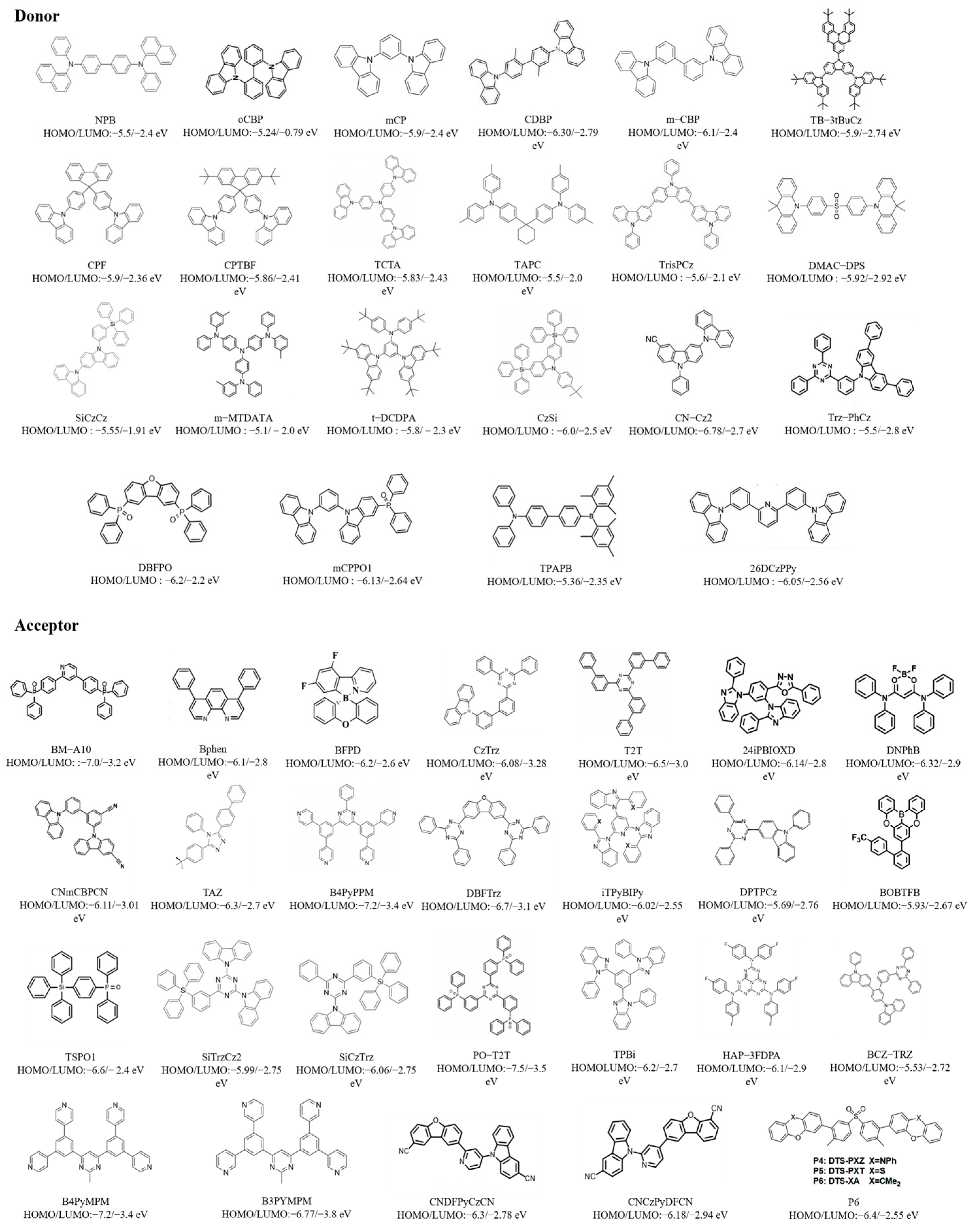


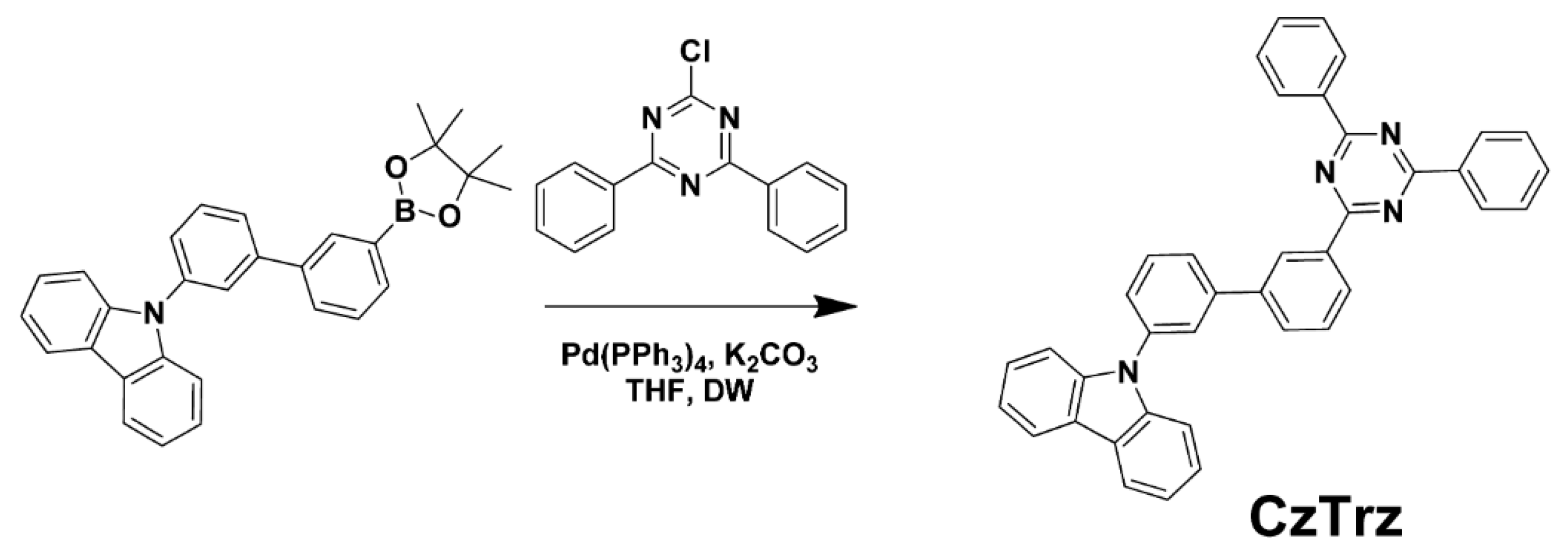
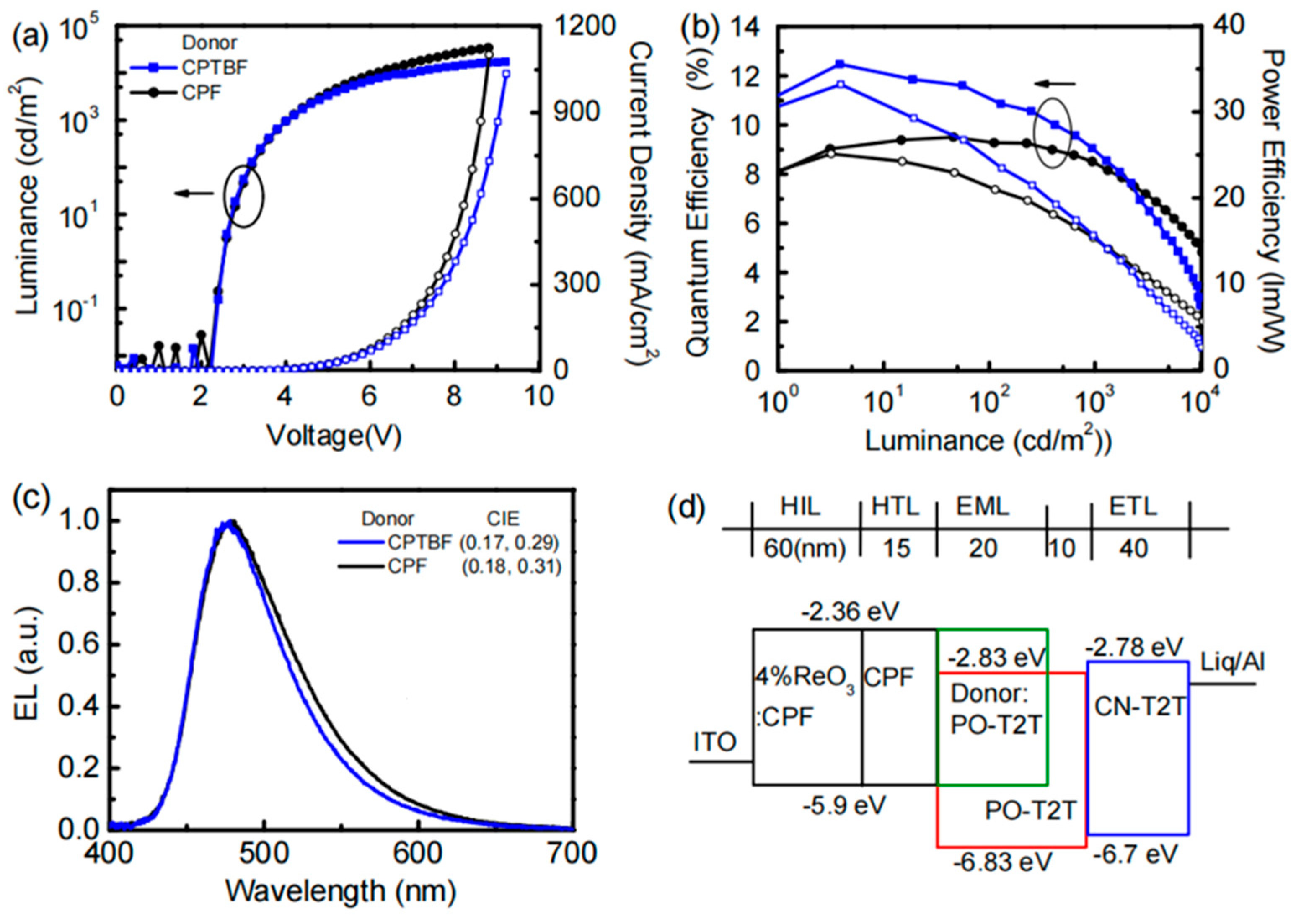





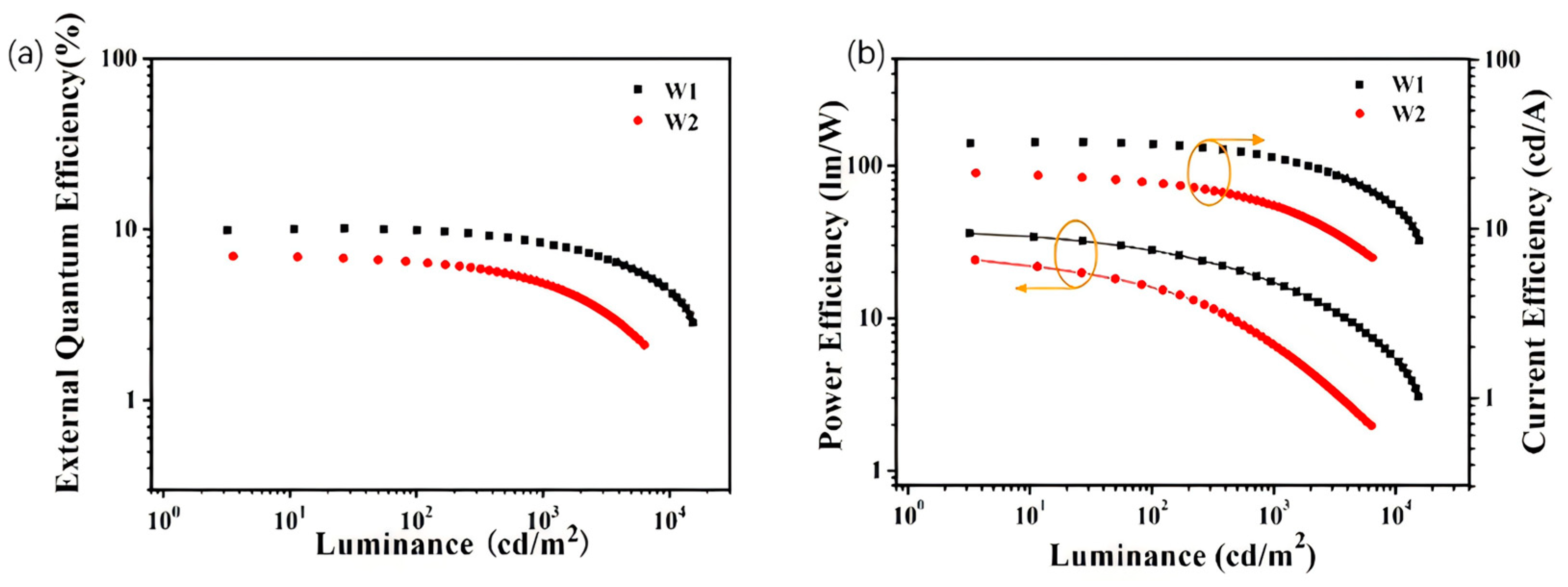
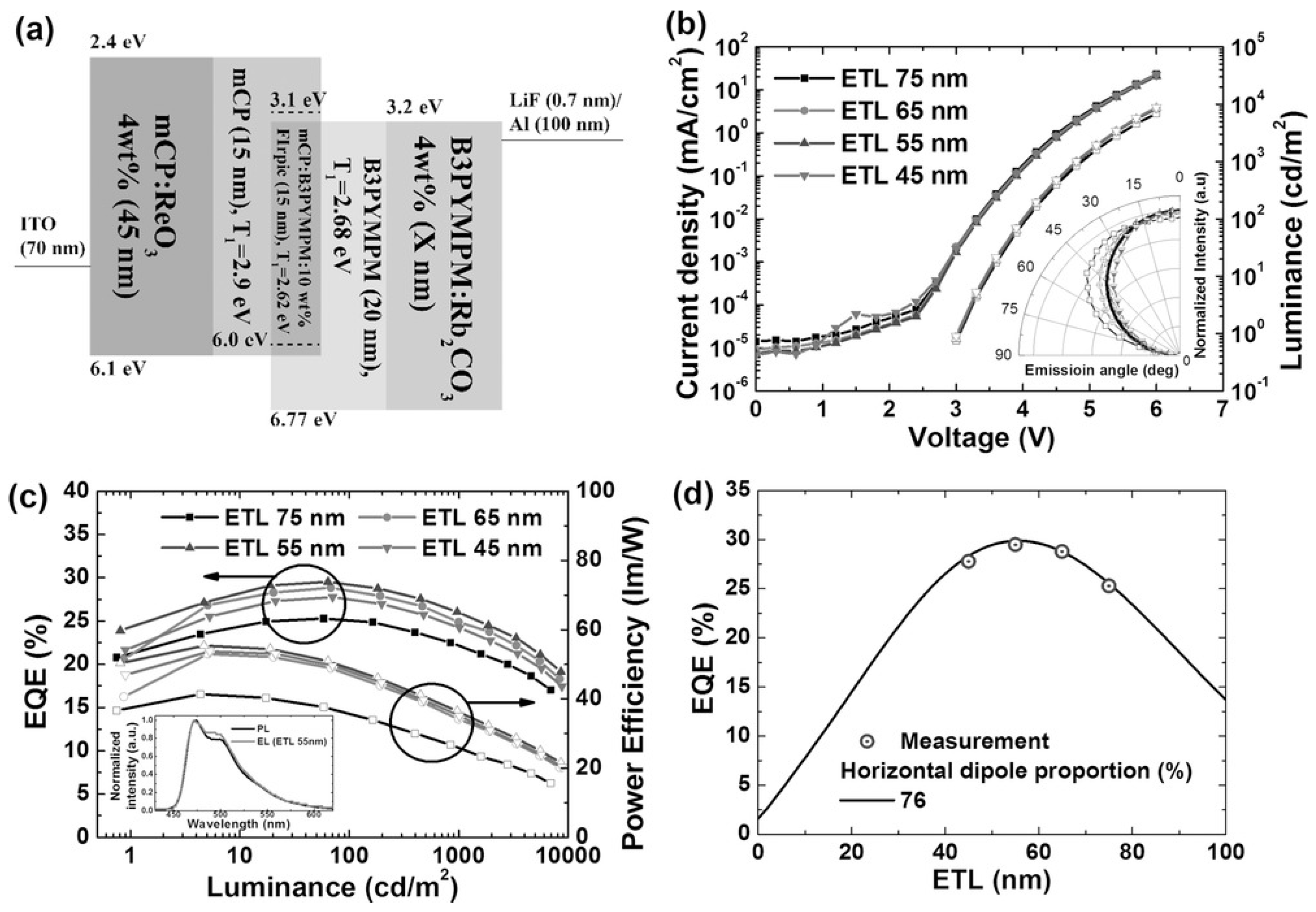


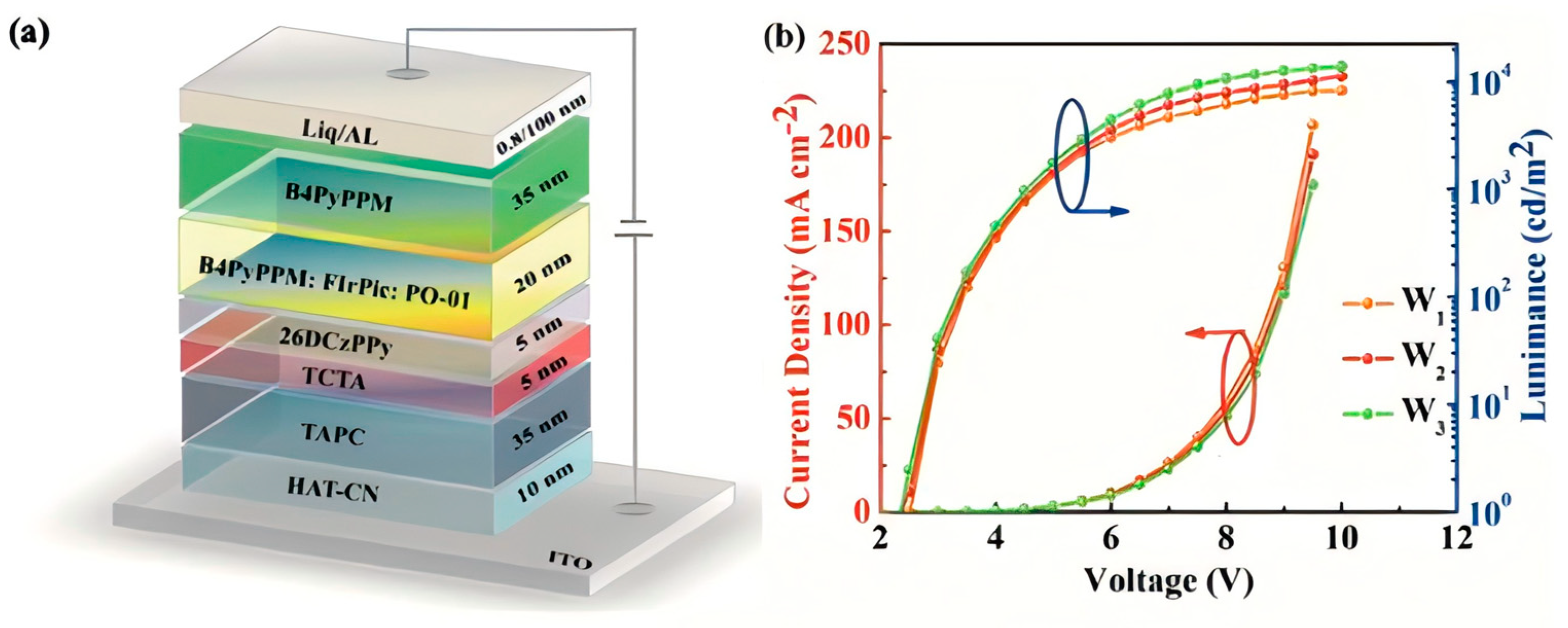


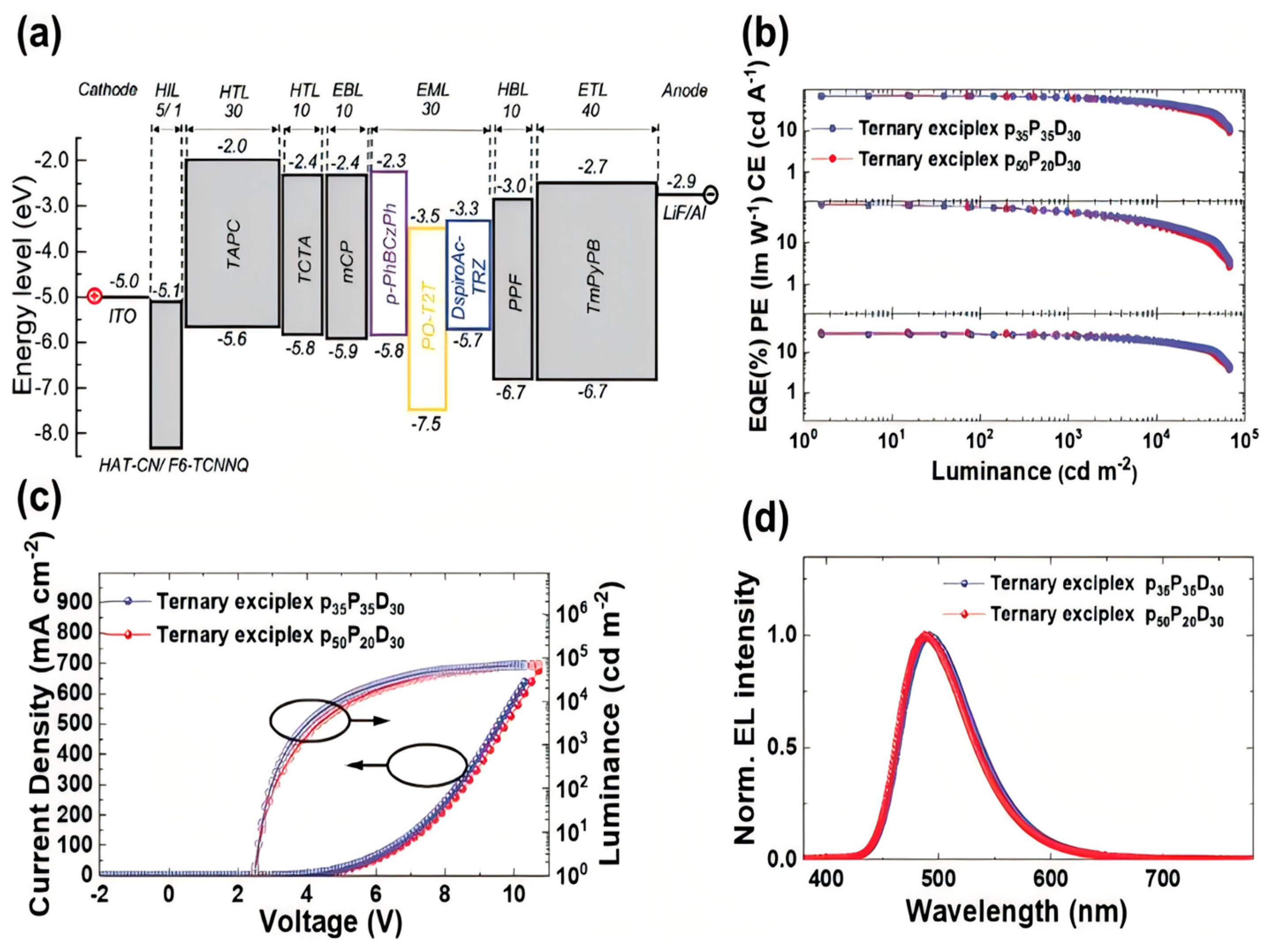
| Exciplex System (EML) | EQE (%) | PE (lm/W) | CE (cd/A) | λEL (nm) | λPL (nm) | Von (V) | FWHM (nm) | CIE Coordinate | S1/T1 (eV) | Type | Ref |
|---|---|---|---|---|---|---|---|---|---|---|---|
| NPB:TPBi | 3.7 | 2.6 | 2.8 | 450 | - | 2.5 | - | (0.15, 0.13) | 2.85/2.80 | Exciplex | [35] |
| TCTA:B3PYMPM | 10.0 | - | - | 495 | 484 | 2.8 | - | - | -/- | Exciplex | [39] |
| mCP:PO-T2T | 8.0 | 18.4 | 15.5 | 471 | 473 | 2.0 | - | (0.17, 0.23) | -/- | Exciplex | [40] |
| NPB:DPTPCz | 0.6 | 1.2 | 1.4 | 491 | - | - | 83 | (0.25, 0.41) | -/- | Exciplex | [28] |
| CDBP:PO-T2T | 13.0 | 27.8 | 26.6 | - | 476 | 2.5 | 77 | (0.17, 0.29) | 2.89/2.86 | Exciplex | [34] |
| mCBP:PO-T2T | 7.66 | 17.78 | 15.08 | - | 473 | - | - | (0.17, 0.23) | -/- | Exciplex | [41] |
| CzSi:PO-T2T | 6.1 | 7.0 | 8.9 | 465 | - | 3.0 | - | (0.16, 0.21) | -/- | Exciplex | [42] |
| mCP:PO-T2T | 16.0 | 26.4 | 27.0 | 480 | - | 3.0 | - | (0.16, 0.28) | -/- | Exciplex | [42] |
| mCPPO1:PO-T2T | 6.5 | 8.0 | 9.4 | 480 | - | 3.0 | - | (0.18, 0.29) | -/- | Exciplex | [42] |
| TCTA:CzTrz | 12.62 | 27.48 | - | 490 | - | - | 85 | (0.27, 0.53) | 2.85/2.85 | Exciplex | [43] |
| CPF:PO-T2T | 9.5 | 22.9 | 21.9 | - | 2.2 | - | (0.17, 0.29) | -/- | Exciplex | [44] | |
| CPTBF:PO-T2T | 12.5 | 33.2 | 27.5 | - | 2.2 | - | (0.18, 0.31) | -/- | Exciplex | [44] | |
| TPAPB:TPBi | 7.0 | 9.1 | 7.2 | 468 | 471 | 3.2 | - | (0.14, 0.18) | 2.66/2.61 | Exciplex | [45] |
| TAPC:10% BFPD | 7.8 | - | 21.7 | 508 | 488 | 4.6 | - | - | 2.88/2.84 | Exciplex | [46] |
| CN-Cz2:PO-T2T | 16.0 | 47.5 | 37.8 | 480 | - | 2.3 | - | (0.20, 0.40) | - | Exciplex | [47] |
| mCP:24iPBIOXD | 0.65 | 0.66 | 0.8 | - | - | 3.8 | - | (0.19, 0.20) | -/- | Exciplex | [48] |
| mCP: iTPBIOXD | 0.63 | 0.74 | 0.9 | - | - | 3.8 | - | (0.20, 0.23) | -/- | Exciplex | [48] |
| mCP:8% HAP-3FDPA | 10.2 | - | - | 437 | 433 | 4.0 | 87 | (0.16, 0.12) | -/- | Exciplex | [24] |
| 26DCzPPy:TB-3tBuCz | 14.6 | 3.1 | 6.6 | 425 | - | 6.5 | 46 | (0.158, 0.052) | 3.07/3.07 | Exciplex | [50] |
| mCBP:DNPhB | 4.83 | 2.2 | 3.04 | 444 | 444 | 3.7 | - | (0.152, 0.075) | 3.27/3.25 | Exciplex | [22] |
| NPB:TAZ | - | 0.36 | 0.75 | 440 | 3.6 | 63 | - | -/- | Exciplex | [51] | |
| TCTA:BOBTFB | 3.49 | - | 4.8 | 469 | 478 | 2.8 | 78 | (0.15, 0.18) | 2.92/2.78 | Exciplex | [52] |
| P6:TCTA | 9.1 | - | - | 433 | - | 6.0 | 101-122 | - | 2.93/2.92 | Exciplex | [53] |
| DMAC-DPS:T2T | 4.44 | - | - | 480 | 480 | - | - | (0.20, 0.37) | -/- | Exciplex | [54] |
| DMAC-DPS: B4PyMPm | 4.40 | - | - | 493 | 493 | - | - | (0.24, 0.42) | -/- | Exciplex | [54] |
| TrisPCz:BCz-TRZ | 11.9 | 33.0 | 33.6 | - | 499 | 3.2 | - | (0.26, 0.50) | -/- | Exciplex | [55] |
| DMAC-DPS:1% PO-T2T | 15.3 | - | 22.0 | 480 | 490 | 6.9 | - | (0.20, 0.41) | -/- | Exciplex | [56] |
| TPA-PPI | 5.02 | 6.13 | 5.66 | 434 | 440 | - | - | (0.15, 0.11) | -/- | Hot Exciton Materials | [57] |
| TPMCN | 2.18 | 1.96 | 2.69 | 463 | 445 | 3.5 | - | (0.15, 0.18) | -/- | Hot Exciton Materials | [58] |
| Py-BPA-BPI | 5.64 | 10.5 | 10.9 | 471 | 469 | 2.15 | - | (0.17, 0.29) | -/- | Hot Exciton Materials | [59] |
| TPEPO | 6.62 | 10.9 | 15.86 | 484 | 490 | 4.0 | - | - | -/- | Hot Exciton Materials | [60] |
| TPP-TXO2 | 10.5 | - | 11.1 | - | 437 | 3.1 | - | (0.152, 0.065) | -/- | Hot Exciton Materials | [61] |
| Exciplex System (EML) | EQE (%) | PE (lm/W) | CE (cd/A) | Von (V) | Ref |
|---|---|---|---|---|---|
| TCTA:Bphen+ PO-01 | 4.3 | 9.03 | 3.6 | 3.0 | [62] |
| CDBP:PO-T2T (WOLED) | 25.5 | 84.1 | 67.0 | 2.5 | [34] |
| CDBP:PO-T2T + TBRb | 11.2 | 21.4 | 27.2 | - | [63] |
| CDBP:PO-T2T + PO-01 | 20.4 | 75.9 | 62.8 | - | [64] |
| mCP:PO-T2T + TAPC:PO-T2T | 7.92 | 11.3 | 16.2 | - | [5] |
| 26DCzPPy:PO-T2T + TBRb | 10.1 | 35.9 | 32.6 | 2.8 | [65] |
| TAPC:26DCzPPY | 1.13 | - | 2.19 | - | [66] |
| TAPC:TPBi + m-MTDATA:TPBi | - | 11.8 | 11.3 | 2.76 | [67] |
| Exciplex System (EML) | EQE (%) | PE (lm/W) | CE (cd/A) | λEL (nm) | Von (V) | Type | Ref |
|---|---|---|---|---|---|---|---|
| mCP:B3PYMPM:FIrpic | 29.5 | 55.4 | 62.2 | - | 3.0 | Sky-Blue Host | [77] |
| mCP:iTPyBIPy:FIrpic | 19.3 | 36.9 | 38.5 | - | 3.2 | Sky-Blue Host | [78] |
| t-DCDPA:DBFTrz:FCNIr | 16.4 | - | 25.2 | - | - | Deep-Blue Host | [79] |
| mCP:BM-A10:FCNIr | 24.0 | 26.0 | - | 455 | 2.9 | Deep-Blue Host | [13] |
| oCBP:CNmCBPCN | 18.8 | 30.3 | 32.8 | 420 | - | Deep-Blue Host | [80] |
| mCP:B4PyPPM:FIrpic | 20.1 | 47.4 | 40.7 | 470 | 2.6 | Sky-Blue Host | [81] |
| mCBP:SiCzTrz:Ir(cb)3 | 27.6 | - | - | 471 | - | Pure-Blue Host | [74] |
| mCBP:PO-T2T + mCBP:B4PyPPM:FIrpic | 25.61 | 54.31 | 45.77 | 470 | - | Sky-Blue Host | [82] |
| DBFPO:TSPO1+TDBA-DI | 41.2 | 87.2 | 72.2 | 458 | 2.5 | Deep-Blue Host | [83] |
| SiCzCz:SiTrzCz2:BD-02 | 25.4 | 25.0 | 30.4 | - | 2.8 | Deep-Blue Host | [85] |
| SiBCz:SiTrzCz2:PtON5N-dtb | 20.4 | - | - | 470 | 2.7 | Deep-Blue Host | [86] |
| oCBP:CNCzPyDFCN+CN–Ir | 29.2 | - | 46.8 | 463 | 2.7 | Blue Host | [87] |
| oCBP:CNDFPyCzCN+ CN–Ir | 26.6 | - | 44.0 | 463 | 2.7 | Blue Host | [87] |
| mCP:B3PYMPM:FIrpic + PO-01 | 20.0 | 75.3 | 64.5 | - | 2.4 | WOLED Host | [88] |
| mCP:B4PyMPM:FIrpic + PO-01 | 28.1 | 105.0 | 83.6 | - | - | WOLED Host | [90] |
| mCP:B4PyPPM:FIrpic + PO-01 | 21.7 | 73.6 | 66.4 | - | 2.5 | WOLED Host | [81] |
| 26DCzPPy:B4PyMPM:FIrpic + PO-01 | 27.3 | 89.0 | 79.0 | - | 2.7 | WOLED Host | [91] |
| 26DCzPPy/B4PyPPM:FIrpic + PO-01 | 23.1 | 101.9 | 81.1 | - | 2.4 | WOLED Host | [92] |
| Trz-PhCz:B4PyMPM + mCBP:B4PyMPM | 36.9 | 137.4 | - | - | 2.2 | WOLED Host | [93] |
Disclaimer/Publisher’s Note: The statements, opinions and data contained in all publications are solely those of the individual author(s) and contributor(s) and not of MDPI and/or the editor(s). MDPI and/or the editor(s) disclaim responsibility for any injury to people or property resulting from any ideas, methods, instructions or products referred to in the content. |
© 2025 by the authors. Licensee MDPI, Basel, Switzerland. This article is an open access article distributed under the terms and conditions of the Creative Commons Attribution (CC BY) license (https://creativecommons.org/licenses/by/4.0/).
Share and Cite
Yan, D.; Zhang, M.; Wang, J.; Jing, X.; Sun, J.; Zhang, Y.; Yang, L.; Sheng, R.; Chen, P. Blue Exciplexes in Organic Light-Emitting Diodes: Opportunities and Challenges. Molecules 2025, 30, 1556. https://doi.org/10.3390/molecules30071556
Yan D, Zhang M, Wang J, Jing X, Sun J, Zhang Y, Yang L, Sheng R, Chen P. Blue Exciplexes in Organic Light-Emitting Diodes: Opportunities and Challenges. Molecules. 2025; 30(7):1556. https://doi.org/10.3390/molecules30071556
Chicago/Turabian StyleYan, Duxu, Mengmeng Zhang, Jintao Wang, Xiaoqing Jing, Jun Sun, Yongan Zhang, Liping Yang, Ren Sheng, and Ping Chen. 2025. "Blue Exciplexes in Organic Light-Emitting Diodes: Opportunities and Challenges" Molecules 30, no. 7: 1556. https://doi.org/10.3390/molecules30071556
APA StyleYan, D., Zhang, M., Wang, J., Jing, X., Sun, J., Zhang, Y., Yang, L., Sheng, R., & Chen, P. (2025). Blue Exciplexes in Organic Light-Emitting Diodes: Opportunities and Challenges. Molecules, 30(7), 1556. https://doi.org/10.3390/molecules30071556






